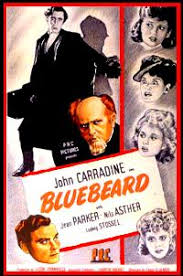
Paris is in a panic. Young women are being murdered, their bodies are found floating in the Seine. The fiend responsible is being called Bluebeard by the authorities. Women are afraid to be out at night alone. Lucille Lutien (Jean Parker) is walking home with her friends Babette (Patti McCarty) and Constance (Carrie Devan) when they run into the puppeteer Gaston Morel (John Carradine). Babette introduces her friends to Gaston and asks him when he will have another performance in the park with his puppets. Gaston is intrigued with Lucille. He says he will give a performance tomorrow night if she will attend. Having never seen the show she agrees. After the show Gaston finds out that Lucille is a Modiste (dressmaker). He asks her if she would make new outfits for his puppets. She agrees.
In the meantime, Gaston’s lover Renee (Sonia Sorel) sees Gaston talking with Lucille and becomes jealous. She makes the mistake of mentioning all the other girls that he had affairs with that are now dead. Gaston strangles Renee and puts her in the Seine. He then reports her missing. Inspector Jacques Lefevre (Nils Asther) takes his statement.
Jean Lamarte (Ludwig Stossel) is an art dealer that Gaston uses to sell his paintings for him. Lamarte is aware of Gaston’s predilections but Gaston’s paintings sell quite handsomely so Lamarte looks the other way. Usually that’s no problem but his last sale was to a Duke that exhibited the painting. Lefevre recognizes the girl in the portrait as one of Bluebeard’s victims and becomes suspicious. Lefevre tries to find out who painted the portrait but Lamarte is sly. Lefevre needs to use a ruse to ferret out the information. Lefevre calls in an undercover agent Francine Lutien (Teala Loring), who happens to be Lucille’s sister.
When Francine discovers that Gaston is Bluebeard she gives herself away. Gaston strangles her. Believing that Lamarte was working with the police Gaston strangles him too and disappears into the sewer system. The police are now nowhere closer to finding Bluebeard than they were before. At least until a small clue to his identity is inadvertently left behind.
“Bluebeard” was released in 1944 and was directed by Edgar G. Ulmer. It is a low budget film noir and a crime thriller.
There are a few things going against this film. First its age. The film is hazy, and the sound is fuzzy. It would benefit greatly from a nice restoration. This is not a reflection on the film but of time. Another problem is the music. It’s constant and overwhelming. Not because it’s loud but because it always there, even when there’s dialogue. When an intense moment happens on screen the music adds nothing to the moment because there’s music every moment. Music, like dialogue should say something and add to the tone and atmosphere of the film. Here it isn’t allowed to. This is not unusual for films that were made during the thirties and forties.
Otherwise the movie is really good. Carradine’s performance is one of the high spots of the film. I can understand why Carradine thought it his best film role. The noir aspects are also done well. The movie starts out just a tad slow but momentum builds and you end up intrigued by it. The good points of the film far outweigh the bad points.
People get confused as to why the film is called Bluebeard. According to Merriam-Webster a "Bluebeard" is a man who marries and kills one wife after another. The verb "bluebearding" refers to either killing a series of women,or seducing and abandoning a series of women. In this case Bluebeard is used to illustrate the type of killer that is prowling around Paris.
The term is based on a French folktale about a man of means who married a young woman and soon after went away leaving his wife the keys to the castle with only one rule. She was not allowed to enter a certain room. She of course did and for her disobedience was killed. Thereafter he continued to marry woman and gave them the same rule. Each time the wife would enter the forbidden room and would find the bodies of previous wives. They all had the same fate for their disobedience. There are many versions to the story. Bluebeard the pirate, as legend would have it, is reputed to be a child killer and pedophile. The term Bluebeard has evolved to be code for serial killer before the term serial killer was coined. At the time the movie takes place Bluebeard was the colloquial term for serial killer.

